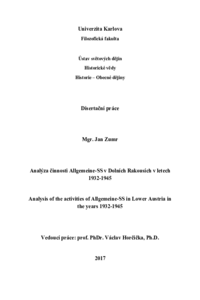Analýza činnosti Allgemeine-SS v Dolních Rakousích v letech 1932 - 1945
Analysis of the activities of Allgemeine-SS in Lower Austria in the years 1932 - 1945
dissertation thesis (DEFENDED)

View/Open
Permanent link
http://hdl.handle.net/20.500.11956/94126Identifiers
Study Information System: 143676
Collections
- Kvalifikační práce [23975]
Author
Advisor
Referee
Koura, Jan
Veselý, Martin
Faculty / Institute
Faculty of Arts
Discipline
General History
Department
Institute of General History
Date of defense
26. 9. 2017
Publisher
Univerzita Karlova, Filozofická fakultaLanguage
Czech
Grade
Pass
Keywords (Czech)
Dolní Rakousy|Allgemeine-SS|nacismus|ilegální aktivity|terorismus|druhá světová válka|Dolní Podunají|Německo|jižní Morava|třicátá létaKeywords (English)
Lower Austria|Allgemeine-SS|nazism|illegal activity|terrorism|Second World War|Lower Danube|Germany|South Moravia|1930sDisertační práce se zabývá zkoumáním role, jakou sehrála SS, resp. Allgemeine- SS, v Dolních Rakousích a v Říšské župě Dolní Podunají od svého vzniku na počátku třicátých let až po konec druhé světové války. Cílem je zanalyzování její činnosti, struktury a personálního obsazení. Její historie vykazovala řadu shodných rysů s dějinami SS v ostatních rakouských spolkových zemích i v samotném Německu, zároveň se zde ale objevovala místní specifika. V Dolních Rakousích/Dolním Podunají měla SS, v závislosti na konkrétním roce, druhý nejvyšší nebo vůbec nejvyšší počet příslušníků v celém Rakousku. Při přepočtu na obyvatele tomu ale bylo přesně naopak. Při srovnání se situací ve "staré říši" vykazovala taktéž podprůměrné počty esesmanů. Tento fakt spočíval v geografickém charakteru a sociální sktruktuře obyvatel země, jehož převážně katolicky konzervativní obyvatelstvo žijící na nížinatém venkově vykazovala vyšší rezistenci vůči vstupu do SS než evangelíci či katolíci žijící v horách. Specifická byla situace na jižní Moravě a jihovýchodním cípu Čech, připojených k Dolnímu Podunají v říjnu 1938. Zde, stejně jako v celém bývalém československém pohraničí, byl počet příslušníků Allgemeine-SS v přepočtu na obyvatele třikrát větší, než kolik činil průměr. V létě 1933 provedla dolnorakouská SS teroristické útoky...
The dissertation deals with the research of a role played by the SS, respectively Allgemeine-SS, in Lower Austria and Reichsgau Lower Danube since its creation in the early 1930s to the end of the Second World War. The dissertation's purpose is to analyse SS activities, structure and staff. Its history showed a number of identical features with the history of the SS in other Austrian Bundesländer and in Germany itself, but at the same time local specifics appeared. In Lower Austria / Lower Danube, the SS had the second highest or even the highest number of members in entire Austria, depending on a particular year. However, conversion to per capita it was exactly the opposite. In comparison with the situation in "the old empire", the SS also showed below average numbers of SS men. This fact consisted in geographic character and population social structure of the country whose predominantly Catholic-conservative inhabitants living in the lowland countryside showed greater resistance to entry into the SS than Evangelicals or Catholics living in the mountains. The situation was specific in South Moravia and the south-eastern corner of Bohemia which were connected to Lower Danube in October 1938. There were, as in the entire former Czechoslovak borderlands, a number of Allgemeine-SS members per capita...
